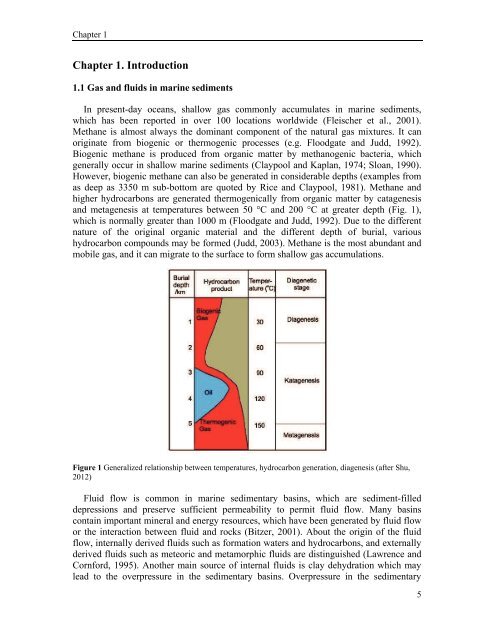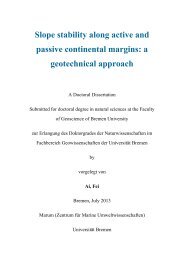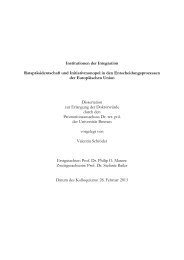Seismoacoustic Study of the Shallow Gas Transport and ... - E-LIB
Seismoacoustic Study of the Shallow Gas Transport and ... - E-LIB
Seismoacoustic Study of the Shallow Gas Transport and ... - E-LIB
You also want an ePaper? Increase the reach of your titles
YUMPU automatically turns print PDFs into web optimized ePapers that Google loves.
Chapter 1<br />
Chapter 1. Introduction<br />
1.1 <strong>Gas</strong> <strong>and</strong> fluids in marine sediments<br />
In present-day oceans, shallow gas commonly accumulates in marine sediments,<br />
which has been reported in over 100 locations worldwide (Fleischer et al., 2001).<br />
Methane is almost always <strong>the</strong> dominant component <strong>of</strong> <strong>the</strong> natural gas mixtures. It can<br />
originate from biogenic or <strong>the</strong>rmogenic processes (e.g. Floodgate <strong>and</strong> Judd, 1992).<br />
Biogenic methane is produced from organic matter by methanogenic bacteria, which<br />
generally occur in shallow marine sediments (Claypool <strong>and</strong> Kaplan, 1974; Sloan, 1990).<br />
However, biogenic methane can also be generated in considerable depths (examples from<br />
as deep as 3350 m sub-bottom are quoted by Rice <strong>and</strong> Claypool, 1981). Methane <strong>and</strong><br />
higher hydrocarbons are generated <strong>the</strong>rmogenically from organic matter by catagenesis<br />
<strong>and</strong> metagenesis at temperatures between 50 °C <strong>and</strong> 200 °C at greater depth (Fig. 1),<br />
which is normally greater than 1000 m (Floodgate <strong>and</strong> Judd, 1992). Due to <strong>the</strong> different<br />
nature <strong>of</strong> <strong>the</strong> original organic material <strong>and</strong> <strong>the</strong> different depth <strong>of</strong> burial, various<br />
hydrocarbon compounds may be formed (Judd, 2003). Methane is <strong>the</strong> most abundant <strong>and</strong><br />
mobile gas, <strong>and</strong> it can migrate to <strong>the</strong> surface to form shallow gas accumulations.<br />
Figure 1 Generalized relationship between temperatures, hydrocarbon generation, diagenesis (after Shu,<br />
2012)<br />
Fluid flow is common in marine sedimentary basins, which are sediment-filled<br />
depressions <strong>and</strong> preserve sufficient permeability to permit fluid flow. Many basins<br />
contain important mineral <strong>and</strong> energy resources, which have been generated by fluid flow<br />
or <strong>the</strong> interaction between fluid <strong>and</strong> rocks (Bitzer, 2001). About <strong>the</strong> origin <strong>of</strong> <strong>the</strong> fluid<br />
flow, internally derived fluids such as formation waters <strong>and</strong> hydrocarbons, <strong>and</strong> externally<br />
derived fluids such as meteoric <strong>and</strong> metamorphic fluids are distinguished (Lawrence <strong>and</strong><br />
Cornford, 1995). Ano<strong>the</strong>r main source <strong>of</strong> internal fluids is clay dehydration which may<br />
lead to <strong>the</strong> overpressure in <strong>the</strong> sedimentary basins. Overpressure in <strong>the</strong> sedimentary<br />
5
















